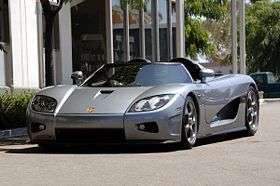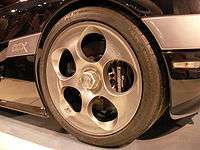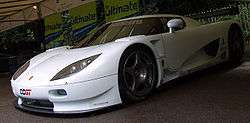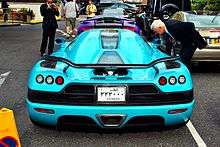Koenigsegg CCX
| Koenigsegg CCX | |
|---|---|
 | |
| Overview | |
| Manufacturer | Koenigsegg |
| Production | 2006–10[1] |
| Model years | 2006–10 |
| Assembly | Ängelholm, Sweden |
| Designer | Christian von Koenigsegg, David Crafoord[2] |
| Body and chassis | |
| Class | Sports car (S) |
| Body style | 2-door targa top |
| Layout | Rear mid-engine, rear-wheel-drive |
| Powertrain | |
| Engine |
4.7 L V8 (twin s/c gasoline/ethanol) 4.8 L V8 (twin s/c gasoline/ethanol) |
| Transmission |
6-speed manual 6-speed automated manual |
| Dimensions | |
| Wheelbase | 2,660 mm (104.7 in) |
| Length | 4,293 mm (169.0 in) |
| Width | 1,996 mm (78.6 in) |
| Height | 1,120 mm (44.1 in) |
| Curb weight | 1,456 kg (3,210 lb) |
| Chronology | |
| Predecessor | Koenigsegg CCR |
| Successor | Koenigsegg Agera |
The Koenigsegg CCX is a mid-engined sports car built by Koenigsegg Automotive AB. The project began with the aim of making a global car, designed and engineered to comply with global safety and environment regulations, particularly to enter the United States car market.[3] To sell cars in the US many alterations were made to the design of the CCR; the previously used Ford Modular engine was replaced by a Koenigsegg engine designed to run on 91 octane fuel, readily available in the United States, and to meet the Californian emission standards.[3][4]
The name CCX is an abbreviation for Competition Coupé X, the X commemorating the 10th anniversary (X being the Roman numeral for ten) of the completion and test drive of the first CC vehicle in 1996.[5]
Overview
The CCX was unveiled at the 2006 Geneva Motor Show, sporting body modifications to meet US regulations and a new 4.7 L twin supercharged V8 engine capable of producing 806 PS (593 kW; 795 hp) at 7000 rpm and 920 N·m (679 lb·ft) at 5700 rpm of torque while running on 91 octane gasoline. There were 49 CCX-Series cars produced between 2006 and 2010 (30 CCX, 9 CCXR, 6 CCX/CCXR Edition, 2 CCXR Special Edition and 2 CCXR Trevita). One of them was a CCX used for Crash tests and one is still a factory test car. CCX cars have later been upgraded to become CCXR-spec.
Powertrain
.jpg)
The new engine is of all aluminum construction, made out of 356 aluminum with a T7 heat treat to further enhance block integrity and cylinder bore chill during casting. Specifically created and cast for Koenigsegg by Grainger & Worrall, a casting specialist with F1 experience in drivetrain components, the engine is built, assembled and tested at their Ängelholm production plant.[4] The engine is lubricated with a dry sump system with a separate oil pump and the pistons are cooled by means of an internal cooler that sprays oil onto them in order to run high cylinder pressure with 91 octane fuel [6] making it capable of 14 mpg (17 l/100 km) in combined cycle and 18 mpg (13 l/100 km) in highway travel.[7] Available transmissions are a Cima 6-speed manual and a 6-speed automated manual.[6] Power is fed to the wheels through a torque-sensitive limited slip differential.[6]
Body
The chassis is made from carbon fiber reinforced with kevlar and aluminium honeycomb like previous models and while the body keeps the targa top body style and the "dihedral synchro-helix" actuation doors[8] it is completely reworked. There is a new front bumper design, enhanced brake cooling, fog lamps, US position lights, a new fresh air intake on the bonnet that acts as ram air booster, air intakes behind the front wheels to enhance airflow and a glass window over the engine.

The CCX has frontal area of 2,894 sq in (1.867 m2) and a drag coefficient of 0.30.,[6] with a CdA of 0.56 m2 (6.0 sq ft). It also has a flat underside with venturi tunnels at the rear and an optional rear spoiler to improve aerodynamics.[6] At 200 km/h (120 mph) there is 60 kg of downforce over the front axle and 65 kg over the rear.[9] The car is 88 mm (3 in) longer to comply with the US rear impact regulations and to free space around the rear muffler. On the interior side, there is 51 mm (2 in) of extra headroom as well as specifically designed Sparco carbon fiber seats.[10]
Wheels and brakes
First in the industry carbon fiber wheels are optional equipment, 3 kilograms (6.6 lb) lighter than the standard forged alloy wheels,[4] both using center locking nuts. Diameter is 19 inches at the front and 20 inches at the rear[6] equipped with 255/35 Y19 front, 335/30 Y20 rear Michelin Pilot Sport 2 tires,[6] 8 piston caliper carbon ceramic brakes measuring 380 mm (15 in) in diameter at the front and 6 piston caliper 362 mm (14.3 in) at the rear are optional, saving another 2 kilograms (4.4 lb) of unsprung weight.[4][6]
Variants
CCXR
 |
Koenigsegg CCX-R
Koenigsegg CCX-R at Goodwood Festival of Speed 2009 |
| Problems playing this file? See media help. | |
The CCXR is a more "environmentally friendly" version of the CCX, powered by the same engine, but converted to use E85 and E100 ethanol fuel, as well as standard 98 octane petrol.[11] The CCXR required modified fuel injectors, upgraded fuel lines and piston rings, and a higher boost setting on the superchargers.[12] When run on ethanol, the power increases to 1,018 PS (749 kW; 1,004 hp) at 7000 rpm and 1,060 N·m (782 lb·ft) of torque at 5600 rpm. This is a direct result of the cooling properties of ethanol in the engine's combustion chambers along with the added boost, made possible by ethanol's higher octane rating when compared to gasoline.[11][13] Due to the lower specific energy content of ethanol, the CCXR burns slightly more fuel than the CCX with a combined fuel consumption of 22 L/100 km (13 mpg-imp; 11 mpg-US) under the EU cycle.
In March 2009 the CCXR was chosen by Forbes as one of the ten most beautiful cars in history.[14]
Edition
.jpg)
At the 2008 Geneva Motor Show Koenigsegg presented two special edition models, the CCX Edition and the CCXR Edition, both fitted with a remapped, 4.8 L twin-supercharged V8 engine and limited to 2 and 4 units respectively.[15] The modifications to the engine increase the power of the CCX Edition to 888 PS (653 kW; 876 hp) and 940 N·m (693 lb·ft) of torque while the CCXR Edition ratings remained unchanged over the CCXR. Later, Koenigsegg also built 2 CCXR Special Edition cars with compared to the old CCXR Edition had updated aerodynamics and a F1 Paddleshift system.
The Edition models are more track oriented compared to the standard models, being equipped with stiffer springs and anti-roll bars, reset dampers and a lowered chassis, a fully visible carbon body, unique 11 spoke wheels and a large adjustable rear wing, and a larger front splitter and side strakes capable of producing 350 kg (772 lb) of downforce at 250 km/h (155 mph).[16][17] The interior is also reworked and features; color matched leather carpets, Koenigsegg Edition side step plates, Edition chronograph instrument cluster, a new Edition only layout for the center console control panels, and features a special version of the Koenigsegg Chronocluster including a redesigned center console. All other extra equipment for the Koenigsegg Edition CCXR and CCX comes as standard: carbon wheels, special interior trim and color, rearview camera, Satnav or Bluetooth, amplifiers, and a complete Inconell exhaust system.
CCXR Trevita
.jpg)
The CCXR Trevita is a limited edition of the Koenigsegg CCXR Edition featuring a diamond weave carbon fibre finish. Trevita is an abbreviation in Swedish and translates into "three whites". Up until the development of the CCXR Trevita, it has only been possible to utilize the classic black carbon fibres.[18] The Koenigsegg Proprietary Diamond Weave, fully developed by Koenigsegg, is a new and unique method to manufacture the carbon fibre material for the CCXR Trevita. By utilising this new and unique method, Koenigsegg has managed to coat fibres with a diamond finish. The process was fully developed at Koenigsegg headquarters in Ängelholm Sweden, where the fibre treatment is conducted carefully in small quantities, prior to further processing the pre-preg material.[19]
Only three CCXR Trevitas were planned to be produced, however, because of the complexity to make the special white carbon-fiber, only 2 were ever made, making it one of the rarest vehicles manufactured by Koenigsegg. Both cars featured the Koenigsegg Shimmering Diamond Weave bodywork, double carbon rear wing, inconel exhaust system, carbon ceramic brakes with ABS, airbags, paddle-shift, chrono instrument cluster, infotainment system, tire monitoring system and a hydraulic lifting system.[20] Floyd Mayweather Jr., and a man in Geneva each own one of the Trevitas.
Specifications
| Models | CCX | CCXR | CCX Edition | CCXR Edition/Trevita/Special Edition | |
|---|---|---|---|---|---|
| Engine | |||||
| Type | 4.7 L (287 cu in) Twin supercharged DOHC V8 | 4.8 L (293 cu in) Twin supercharged DOHC V8 | |||
| Power | 806 PS (593 kW) at 7000 rpm | 1,018 PS (749 kW) at 7200 rpm | 888 PS (653 kW) at 7000 rpm | 1,018 PS (749 kW) at 7000 rpm | |
| Torque | 920 N·m (679 lb·ft) at 5500 rpm | 1,060 N·m (782 lb·ft)at 6100 rpm | 940 N·m (693 lb·ft)at 5800 rpm | 1,080 N·m (797 lb·ft) at 5600 rpm | |
| Performance (mfr estimates) | |||||
| 0-100 km/h (62 mph) | 3.2 | 3.1 | 3.0 | 2.9 | |
| 0-200 km/h (124 mph) | 9.8 | 8.9 | 9.1 | 8.8 | |
| 0-200 km/h (124 mph)-0 | 14.0 | 13.7 | 13.9 | 13.0 | |
| Top speed | over 395 km/h (245 mph) | over 400 km/h (249 mph) | |||
Motorsport

In order to compete in the FIA GT Championship Koenigsegg created the CCGT race car, based on the production CC model range; making its debut appearance at the 2007 Geneva Motor Show and build to comply with in the ACO and FIA regulations for the GT1 class.[21]
The CCGT engine is based on the Koenigsegg CCX production engine with the superchargers removed and its capacity increased to 5.0 L to compensate for the loss of power.[21] Due to the already lightweight construction of the road-going model it was based on, the weight was easily reduced under the minimum 1,100 kg (2,425 lb), which means that the Ballast can be placed optimally in order to meet the mandatory weight.
As the car was just being finished the FIA GT1 regulations were changed so that there had to be a minimum of 350 road cars produced per year of the model that was to compete, something that Koenigsegg was unable to achieve, prohibiting the CCGT from racing.[22]
Awards and recognition
- 2009 Best Performing Green Exotic, duPont Registry[23]
- One of the 10 Most Beautiful Cars by Forbes magazine
In 2007, the CCX was the fastest car to complete Top Gear's Power Lap with a time of 1:17.6 (until it was beaten by the Ascari A10 with a time of 1:17.3).[24] The car originally lapped the circuit in 1:20.4, but was then fitted with an optional rear wing to provide downforce after the show's test driver (The Stig) spun it off the track. The Stig purportedly recommended this modification, predicting that the car would then be the fastest ever round Top Gear's track[25] but Koenigsegg later stated that the improvement was due to adjustments to the chassis and suspension settings and not the addition of the rear spoiler. Despite this, the Stig's spoiler-idea remained the credited reason for the improved lap time.[26]
References
- ↑ http://koenigsegg-registry.net/overview.shtml
- ↑ "The Italian Junkyard: 20.1 Sweden Ain't That Cold: Christian Von Koenigsegg gives us a quick interview on how he made his dream come true". theitalianjunkyard.blogspot.se.
- 1 2 Vaughn, Mark (2006-10-30). "2006 Koenigsegg CCX". Autoweek. Retrieved 2007-09-06.
- 1 2 3 4 "Design Elements". Koenigsegg. Archived from the original on 2007-08-11. Retrieved 2007-09-01.
- ↑ "The new CCX". Koenigsegg. Archived from the original on 2007-08-11. Retrieved 2007-08-31.
- 1 2 3 4 5 6 7 8 "CCX Specifications". Archived from the original on August 11, 2007. Retrieved 2012-06-22.
- ↑ "Official website of the Swedish super sports car manufacuturer". Koenigsegg. Retrieved 2010-02-26.
- ↑ "The Doors". Koenigsegg. Archived from the original on 2007-08-07. Retrieved 2007-09-05.
- ↑ Kuah, Ian (2006-08-17). "Koenigsegg CCX". Piston Heads. Retrieved 2007-09-07.
- ↑ "Koenigsegg CCX Press Release". Retrieved 2012-06-22.
- 1 2 Grunet, Peter (2007-06-01). "Herbal Essence". Top Gear Magazine. pp. 138–142.
- ↑ Whitworth, Ben (2007-06-03). "A green Koenigsegg? Surely some mistake?". Car Magazine. Retrieved 2007-09-05.
- ↑ "CCXR Technical Specifications". Koenigsegg. Archived from the original on 2007-10-25. Retrieved 2007-09-05.
- ↑ Elliott, Hannah (March 26, 2009). "World's Most Beautiful Cars". Forbes.
- ↑ "Exclusive: Koenigsegg cuts production numbers on the CCX & CCXR Edition | Cars UK | UK Car News". Cars UK. 2009-03-19. Retrieved 2009-04-28.
- ↑ "CCXR Edition specifications". Retrieved 2012-05-24.
- ↑ "CCX Edition specifications". Retrieved 2012-05-24.
- ↑ Press Release, Koenigsegg (September 9, 2009). "The Koenigsegg Trevita - The Shimmering Diamond".
- ↑ "Koenigsegg's Trevita is unique". The Washington Times. 2009-09-18. Retrieved 2009-10-12.
- ↑ "Koenigsegg Trevita". GTspirit.com. 2009-09-10. Retrieved 2009-10-12.
- 1 2 "Autoblog: Koenigsegg drops a duo". Retrieved 24 May 2012.
- ↑ "Koenigsegg CCGT specifications". Retrieved 24 May 2012.
- ↑ Ramsey, Jonathon (2008-10-09). "duPont Registry's 11 "Best of" cars set horsepower, price records". Autoblog. Weblogs, Inc. Retrieved 2008-03-20.
- ↑ "Top Gear - Power Laps". BBC. Retrieved 2007-10-15.
- ↑ "Season 8, Episode 1". Top Gear. 2006-05-07. - Jeremy Clarkson: "After the accident, Stig said he reckons this car would be 4 seconds faster than it was if it had a big wing on the back."
- ↑ Svensson, Gunnar (2006-06-05). "Koenigsegg får Top Gear-vinge" (in Swedish). Bilsport. Retrieved 2007-03-12.
External links
| Wikimedia Commons has media related to Koenigsegg CCX. |
